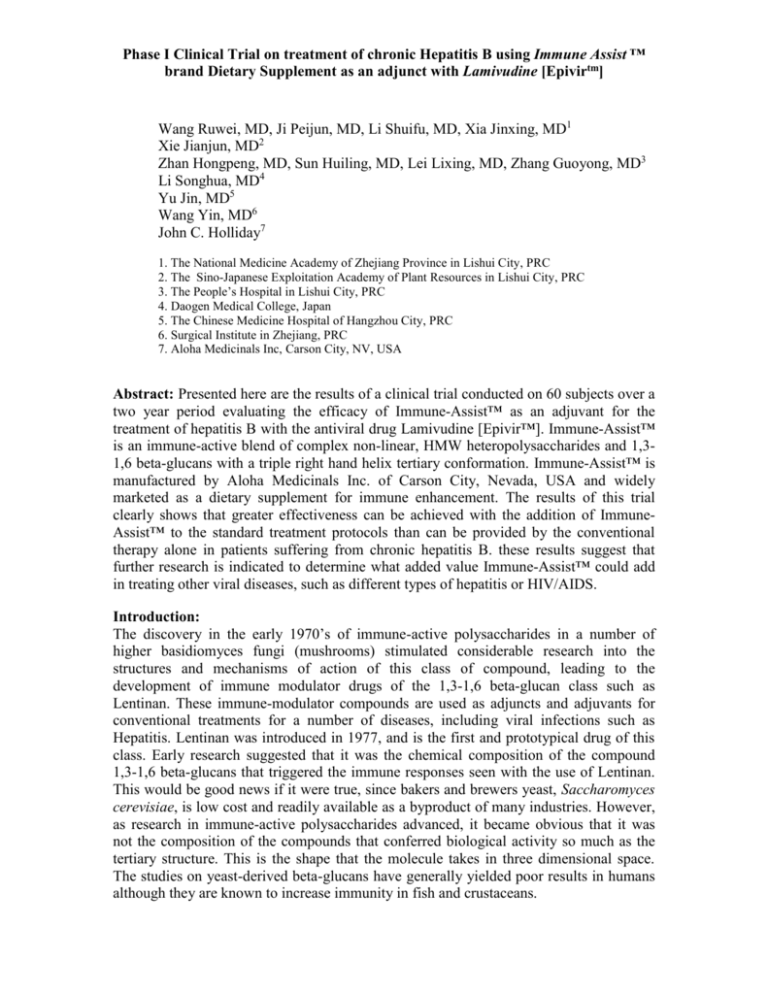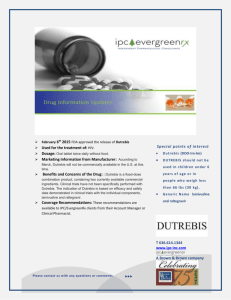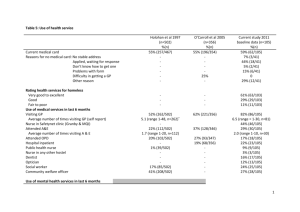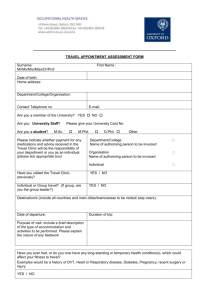Clinical Trial on treatment of Chronic Hepatitis B with IMMUNE
advertisement

Phase I Clinical Trial on treatment of chronic Hepatitis B using Immune Assist ™ brand Dietary Supplement as an adjunct with Lamivudine [Epivirtm] Wang Ruwei, MD, Ji Peijun, MD, Li Shuifu, MD, Xia Jinxing, MD1 Xie Jianjun, MD2 Zhan Hongpeng, MD, Sun Huiling, MD, Lei Lixing, MD, Zhang Guoyong, MD3 Li Songhua, MD4 Yu Jin, MD5 Wang Yin, MD6 John C. Holliday7 1. The National Medicine Academy of Zhejiang Province in Lishui City, PRC 2. The Sino-Japanese Exploitation Academy of Plant Resources in Lishui City, PRC 3. The People’s Hospital in Lishui City, PRC 4. Daogen Medical College, Japan 5. The Chinese Medicine Hospital of Hangzhou City, PRC 6. Surgical Institute in Zhejiang, PRC 7. Aloha Medicinals Inc, Carson City, NV, USA Abstract: Presented here are the results of a clinical trial conducted on 60 subjects over a two year period evaluating the efficacy of Immune-Assist™ as an adjuvant for the treatment of hepatitis B with the antiviral drug Lamivudine [Epivir™]. Immune-Assist™ is an immune-active blend of complex non-linear, HMW heteropolysaccharides and 1,31,6 beta-glucans with a triple right hand helix tertiary conformation. Immune-Assist™ is manufactured by Aloha Medicinals Inc. of Carson City, Nevada, USA and widely marketed as a dietary supplement for immune enhancement. The results of this trial clearly shows that greater effectiveness can be achieved with the addition of ImmuneAssist™ to the standard treatment protocols than can be provided by the conventional therapy alone in patients suffering from chronic hepatitis B. these results suggest that further research is indicated to determine what added value Immune-Assist™ could add in treating other viral diseases, such as different types of hepatitis or HIV/AIDS. Introduction: The discovery in the early 1970’s of immune-active polysaccharides in a number of higher basidiomyces fungi (mushrooms) stimulated considerable research into the structures and mechanisms of action of this class of compound, leading to the development of immune modulator drugs of the 1,3-1,6 beta-glucan class such as Lentinan. These immune-modulator compounds are used as adjuncts and adjuvants for conventional treatments for a number of diseases, including viral infections such as Hepatitis. Lentinan was introduced in 1977, and is the first and prototypical drug of this class. Early research suggested that it was the chemical composition of the compound 1,3-1,6 beta-glucans that triggered the immune responses seen with the use of Lentinan. This would be good news if it were true, since bakers and brewers yeast, Saccharomyces cerevisiae, is low cost and readily available as a byproduct of many industries. However, as research in immune-active polysaccharides advanced, it became obvious that it was not the composition of the compounds that conferred biological activity so much as the tertiary structure. This is the shape that the molecule takes in three dimensional space. The studies on yeast-derived beta-glucans have generally yielded poor results in humans although they are known to increase immunity in fish and crustaceans. Immune Assist Hepatitis Trial 2 The city of Lishui, which lies in the south-west of Zhejiang province, is one of the major mushroom cultivation districts in China and has rich resources of these edible fungi. It is a long-standing tradition for the populace of this area and other parts of China to use the edible fungi as part of their medicine. While researching the traditional medicine and folk recipes of the people of this area, there is found a widespread belief that edible fungi can protect the liver, reduce obesity and improve overall immunity. In accordance with this traditional belief, this study was designed using modern extraction methods in the preparation of a mushroom polysaccharide mixture according to the formula of ImmuneAssist Critical Care Formula™, a proprietary health supplement developed as a joint project between the Government of Zhejiang province and a privately held American company, Aloha Medicinals Inc. of Maui, Hawaii. This mixture is manufactured and distributed in the United States of America by Aloha Medicinals Inc. The formula is composed of purified alcohol-precipitated hot water extracts of six species of medicinal mushrooms: Lentinula edodes, Agaricus blazei, Grifola frondosa, Coriolus [Trametes] versicolor, Ganoderma lucidum and two types of Cordyceps sinensis extracts, one from the mycelium and one from the culture broth of liquid-fermented Cordyceps sinensis. We tested this mixture concurrently with the accepted drug lamivudine in the cure of chronic hepatitis. With lamivudine therapy alone, the rate of hepatitis Be antigen convertion from positive to negative is 10%-20% with a one year course of therapy, and this antibody seroconversion to negative increases by continued use of lamivudine past the first year. Because of this long treatment period, there is concern that the virus will induce genetic variation, as well as the possibility of some subjects discontinuing the therapy after time due to attrition or economic hardship. From February 2000 to August 2001, our research group used the Immune Assist™ formula and lamivudine together to treat hepatitis B for a period of nine months. From April in 2001 to May in 2002, we also used this formula and lamivudine together to treat hepatitis B compounded with hyperlipidemia, with good results. This trial was performed under the guidelines of informed consent and good clinical practice. The Peoples Republic of China clinical trial sanction number for this trial was 99-118. Key words: Immune-Assist, mushroom polysaccharide, medicinal mushrooms, Hepatitis, Hyperlipidemia, HbsAL/HbeAg, Lamivudine Formula and preparation method 1.1 Formula: This trial was conducted using Immune Assist™ tableted at 500 mg of active ingredients ea. Each tablet contained 500 mg mixture of active ingredients consisting of equal parts of the heteropolysaccharides and 1,3-1,6 beta glucans derived from the following species of laboratory cultivated fungal fruitbodies and mycelium: Lentinula edodes polysaccharides (Lentinan), Grifola frondosa polysaccharides (Maitake D-Fraction), protein-bound polysaccharides from two strains, COV-1 and 441 Strain of Trametes versicolor (PSK and PSP), Cordyceps sinensis Polysaccharides and exo-polysaccharides, Agaricus blazei Polysaccharide and Ganoderma lucidum polysaccharides. These polysaccharides were extracted from the full spectrum mycoproducts grown by sterile tissue culture using a proprietary two step extraction and purification process consisting of extraction with hot water, repeated 4 times at 98-99 degrees C, concentration of the water extract portion under reduced pressure, then addition of 4 times the volume of pharmaceutical grade ethanol, which causes the alcohol insoluble polysaccharides, protein bound Immune Assist Hepatitis Trial 3 polysaccharides and heteropolysaccharides to precipitate from the solution. The precipitated polysaccharide compounds were then collected and spray dried. This purified protein-polysaccharide complex is blended with pharmaceutical binders and excipients to manufacture tablets as per usual tableting protocols. Quality control standard 2.1 Character: The tablet is composed of granular material, light brown with a characteristic taste and smell. 2.2 Differentiation and verification: (1) Analytical protocol: To 1.0 g of the ground tablets add 2 mol/L solution of hydrochloric acid. Next add ninhydrin, 2 mg, slowly heating so the solution changes from deep blue to light blue color. (2) To 1.0 g of the ground tablets add 20ml water to dissolve. To 5ml of this solution add silver nitrate 2.5ml and a black deposition of silver appears. 2.3 This product should measure up to all the medicine rules in the first addendum of “The Codex in the People’s Republic of China” (Edition 1). 2.4 Shelf life experiment: Divide the tablets into 3 groups and store them under normal temperature. Periodically perform character differentiation, assay the solubility in water, and differentiate with computer aided analytical equipment GC, FTIR and HPLC spectroscopy to assure a minimum of 90% conformance with datum as-manufactured. Confirm sterility with SPC method for total CFU count, yeast and mold and e-coli in January, February, March, June, and December. All the datum accords with the related rules in the first addendum of “The Codex in the People’s Republic of China” (Edition 1). Toxicity experiment (presided over by Li Songhua MD at Daogen Medical College in Japan ) 3.1 Acute toxicity experiment: 20 baby mice (20±1g each, half male half female), administer P.O. a solution of the polysaccharide tablet 3 times / 24 hours (500 mg for each mouse every time), total dose is 75g/kg/day. Maintain this dosage for 7 days and otherwise feed according to normal. At the end of the seven days all the mice are healthy and none show any signs of toxicity or abnormality. This short-term overdosage is approximately 835 times the normal recommended human adult dosage on a mg/kg basis. 3.2 Long-term toxicity experiment: 80 healthy adult mice were administered the solution P.O. at 10g/kg/day for 90 days. At 90 days, the mice are sacrificed and all organs assayed for signs of toxicity. The mice showed no abnormal characteristics and the tissues show no toxicity changes. This confirms that this product has little toxicity for long-term administration Clinical observation 4.1 The trial group consisted of 60 subjects who have complete datum agreement for hepatitis B since February 2000. These cases are all in accordance with the chronic hepatitis B diagnostic standard which was made at the Beijing conference in 1995. That is to say, HbsAg and HbeAG are both positive. The subjects are divided into two groups: the experimental group and the control group. The experimental group consists of 32 subjects: 19 males and 13 females, whose ages range from 16 y to 55 y with the average age of 32 y. Among these cases, the lightly sick number 10 individuals and the moderately sick are 22 in number. The comparison group consisted of 28 cases: 16 Immune Assist Hepatitis Trial 4 males and 12 females, with ages from 14 y to 53 y and an average age of 31 y. Among these cases, the lightly sick are 9 in number and the moderately sick number 19 individuals. As far as sex, age and degree of disease considerations, there is no apparent differentiation between the groups. (P>0.05). Treatment Methods These two groups were all treated by accepted medical protocol. Lamivudine was administered 100 mg per day for a period of 9 months. Fufangyiganling™ or Ganlixinpian™ was also given 3 times a day, 4 tablets in each dose and continued for 6 months. The experimental group was treated the same, except for the addition of the Immune Assist™ mushroom polysaccharide tablets, 18 tablets per day divided into 3 doses, for a total daily dosage of 9 grams, continued for 9 months. During the treatment period, the two groups were checked for hepatic function every other month as well as checking the hepatic antigen and antibodies. Treatment Standards Rating 4.2 Treatment efficacy standards: Marked effect: The main symptoms disappear, swelling and inflammation of the liver and spleen subsides, hepatic function becomes normal as indicated by liver enzyme panel, and one or more of either the HbsAL or HBeAg converts to negative. Moderate Effect: The symptom improve, swelling and inflammation of the liver and spleen subsides or becomes steady, the hepatic function approaches normal or becomes normal, but neither the HbsAL or the HBeAg converts to negative. Ineffective: None of the above datum is approached. Treatment result 4.3 In the experimental group, there are 20 cases of marked effect, 7 cases of Moderate Effect, and 5 cases with no apparent effect. The totally efficiency of treatment in the Immune Assist™ group is 84.4%. In the control group there are 8 cases of marked effect, 15 cases of Moderate effect, 5 cases with no apparent effect. The totally efficiency is 82.1%. The totally efficiency difference of these two groups has no apparent meaning (P>0.05). See Table 1 below: Table 1 - Overall Effectivness 25 20 20 15 10 5 15 7 5 8 Marked Effect Moderate effect 5 No Effect 0 Expermental group w/ImmuneAssist Control group no Immune-Assist Table 1 – Effectivness comparison of lamivudine alone compared to lamivudine & Immune-Assist Comparison of rate of hepatitis seroconversion from positive to negative Immune Assist Hepatitis Trial 5 4.4 After 9 months of treatment, 20 cases of HBeAg in the Immune Assist™ group convert to negative (62.5%), while only 8 cases of HbeAg in control group convert to negative (28.6%). The seroconversion rate of these two groups is significant (P<0.05). See Table 2 below: Table 2 - Antibody changing from Positive to Negative After 9 months of treatment 25 20 15 10 5 0 20 20 12 8 Experimental Group w/ Immune Assist Neg Antibody Test Pos Antibody Test Control Group No Immune-Assist NOTE: The rate of change in the Antibody test from Positive to Negative is 62.5% for those subjects treated with Immune-Assist compared to only 28.6% for those treated with Lamivudine alone. Subjects whose HBeAg convert to negative in these two groups continue to take Lamivudine for another 3 months. There are 3 cases whose HBeAg returns to positive after stopping the medication in the Immune Assist™ group, and 1 case in the control group. There is no apparent meaning. Discussion There are two treatment methods to cure hepatitis B in the world today: one is to effect a cure through antiviral drug activity, the other is by assisting the immune system to fight the disease. When inflammation is promoted by the reproduction of the virus, the main treatment method for chronic hepatitis is through the use of an antiviral drug. Up until now the efficiency of antiviral therapy is the decrease of HBV-DNA (<0.1pg/ml) and the elimination of HBeAg. These results are related to changes of the inflammatory necrosis or damage to the liver, and the reduction of communicability of the viremia. After antiviral therapy, HBeAg and HBsAg often convert to negative. However, HBVDNA can still be confirmed in serum and liver by PCR analysis, which means that the viral disease still exists. Because of this it is clinically significant that we choose seroconversion of HBeAg as the main guideline for effective treatment. The antiviral drugs that are certified in international medical protocols are interferon and lamivudine. But since interferon only can be used under the rigorous observation of veteran doctors within adequate facilities for patient monitoring, there are only a small portion of subjects which can be treated in this manor out of the millions of cases worldwide. Lamivudine is similar to a nucleotide and causes a type of pyrimidine ramification. It is synthetically manufactured and is an L-structured artificial enantiomorph. It is a strong and safe inhibitor for the replication of HBV. It can play a great role in wide treatment usage for Hepatitis B, but it is not fit for all chronic hepatic infections. The medicine for chronic hepatitis infections should restrain the synthesis of HBV-DNA and eliminate CCC-DNA, but does not rely on the immunological activity of Immune Assist Hepatitis Trial 6 the subjects themselves. It has proven very difficult to produce any medicines with both direct antiviral and immunomodulatory activity to date. Measurments of HbsAL / HBeAg indicators have one or more advantages in assessing treatment effecacy. First, this can accurately choose medicines for treatment and let these medicines exert their advantages singly or in combination; and secondly, it can improve the treatment effect concurrently with other medicines. However lamivudine takes a long time to display its disease resistance role when used as a singular drug therapy, with a seroconversion rate from positive to negative for HBeAg taking 3 to 4 years to achieve efficacy in 60% of subjects, and it is likely to induce virus genetic variation if taken for a long period of time. So we used the mixed medicine approach of direct acting antiviral and immune modulation effect of the immune activating polysaccharides together to treat hepatitis in a shorter timeframe than would usually be expected, and use Chinese medicine (TCM) alone for long-term follow-up. According to the experience of these authors over more than eighteen months involvement in this study, when we use the mushroom polysaccharides and lamivudine together, the sensitivity to the lamivudine can apparently be increased. The multi-targeted antiviral activity of Chinese medicine, mushroom polysaccharide immune modulation and the concurrent direct acting antiviral activiuty of lamivudine makes up for the short comings of lamivudine alone, for example by allowing shorter periods of treatment, greater reduction in swelling and inflammation, and decreased toxic side effects, and this shorter duration therapy can lead to greater patient compliance. According to the references cited below [2-4], edible fungi have many significant biological functions. They can prolong the patient’s dormancy period, increase appetite, ameliorate fatigue and enhance immunity. They can strengthen the body’s nonspecific immunity, improve the secretory product of mucosa’s secretor type IgA, increase the function of mononuclear-phagocyte and the activity of NK cells, maintain immune homeostasis, ameleorate alcoholic damage to liver cell efficiency and accelerate the restoration and regeneration of liver tissue cells. Edible fungi also have shown attenuation of virulence, to improve the body’s overall health, protect hemopoietic action of bone marrow, and reduce damage of the esophagus. Edible fungi have proven therapeutic effect for chemical liver damage and healthy blood lipid regulation, and can play an effective function in clinical medicine. From this trial we find that the mushroom polysaccharides in Immune Assist™ can play an important roll in the treatment of hepatitis B, and this mushroom polysaccharide mixture Immune Assist™ should be considered as an adjunct to conventional hepatitis treatment with the nucleotide type antiviral drugs. Reference: 1. Wang Jiyao The Curing of Modern Hepatitis, Shanghai Medicial College Publishing House, 1999,26 2. Hileino H, Yoshxaha M, Suzuk Y, et al. Isoation and hypoglycemic activity of trichosons A.B.C.D. and E, glycans of trichosanthes kirilowii root, planta med, 1989; 55(4); 349 3. EA Boxle et al. Pharma pharmacol 1982; 34; 563 4. Li Guangzhou Research for Increasing Antineoplastic Function of lentinan, The Application Medicine in China 2000, 17(5):354-355 Note 1 – The original Immune-Assist™ manufactured Aloha Medicinals Inc. is marketed in the form of capsules containing no inactive ingredients or additives, but for the Immune Assist Hepatitis Trial 7 purposes of this study it was decided to administer the compound in the form of tablets to make them indistinguishable from the placebo. The tablet exipients were pharmaceutical grade materials as used in normal tableting protocols. Otherwise, the formula used in this study was identical to that of the commercially available Immune Assist™ product.








